Did you know that drinking mineral-rich water is essential to your health and wellness? It’s the way nature intended it to be after all. Alkaline water full of life-giving micro and macro minerals not only makes water taste better, but is also vital to your health and well-being according to the World Health Organization (WHO) in its book, Nutrients in Drinking Water.
It’s especially important to add minerals to Reverse Osmosis (RO), distilled, and even some purified bottled waters, because they are often stripped of minerals and may even be acidic as I discussed in this recent post, “Are You Unknowingly Drinking ‘Dead’ Water Void of Essential MInerals?” But you may also want to find a way to filter and enrich plain tap water as well.
Here are some easy ways to make your water more alkaline and mineral-rich whether you are at home, at work, or on the go. You may find that a combination of these solutions works best for you. Let me know your thoughts and if you have any other ways to add minerals back into your water.
1. Add trace mineral drops to your water
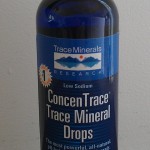
Trace Minerals Research ConcenTrace Mineral Drops are GRAS affirmed and have a reduced sodium content.
Do you enjoy mineral water? Adding trace mineral drops to your water will make you think you’re drinking mineral-rich water from a coveted natural source. You’ll actually enjoy your water again, because it tastes so much better. Plus, it’s easy to quickly add a few drops to a glass of water, water bottle, or even a pitcher for the whole family to enjoy.
Trace mineral drops include micro minerals that your body needs in very small amounts, such as chromium, copper, manganese, molybdenum iodine, selenium, iron, and zinc. Many drops also contain a fair share of magnesium, an important macro mineral. Adding minerals to water makes them much more easily absorbed by the body, because they are in their electrolyte or ionic form. You also get the advantage of taking in a steady supply of these minerals as you drink water throughout the day. Plus, they are relatively inexpensive. An 8 oz. bottle usually costs under $20 and may allow you to re-mineralize anywhere from 100 to 200 gallons of water.
2. Add a mineral-rich sea salt to your water
Nope. I’m not talking about your standard, run-of-the mill table salt, but instead a mineral-rich, non-processed salt, such as Himalayan sea salt, which is full of 84 trace minerals. You can add a pinch to a glass of water (it shouldn’t taste salty) or about 1/4 tsp. to a gallon of water. I’ve tried it and it tastes fine. The trick is to use fine salt, so that it dissolves easily. By the way, it’s an inexpensive solution for adding trace minerals, because two pounds cost well under $10.
Another option is to make a mixed salt solution to store in a glass dropper bottle and then use that to re-mineralize your water as explained on this website, Dancing With Water. The site also sells a salt blend which includes salts from around the word, such as Celtic Grey, Hawaiian Red, Redmond Real, French Grey, etc. The idea of using a salt blend — or even of rotating them — may be good because you get the benefit of different minerals that way.
3. Use a water bottle that filters and infuses your water with ionic minerals

Make filtering and re-mineralizing your water easy with this stainless steel water bottle you can take anywhere.
Want something you can take with you and use anywhere that not only infuses regular tap water with ionized minerals, but also filters it? Then check out this Aqua Sanitas water bottle with a patented combination of 13 minerals. The kaolin clay and nano silver helps filter the water of chlorine and contaminants. The minerals, negative ion balls, and more give the water a pleasant soft taste. It’s made of surgical steel, comes in a variety of colors, and has a removable filter at the top, which you need to replace once a year, and a mineral disk built into the bottom of the bottle that lasts for five years. From my understanding, the bottle will soon be retailing in the U.S. for under $100. (For a similar, but much less expensive option, check out the alkaline water flask by Santevia, which also offers other products as mentioned in #4 below.)
4. Use an alkaline pitcher to add minerals back in
If you want the convenience of a pitcher, you might be interested in this one made by Santevia that filters water, raises the pH, and also adds back in calcium, magnesium, and other beneficial minerals. It comes in four fun colors and the filter life is 80 gallons. Plus, the lid has a handy built-in countdown clock so that you know when to change the filter. It retails for about $59 and the replacement filters come in a 3-pack for $43.99. By the way, the company also makes several other products, such as an alkaline water stick you can add to a water bottle, a stainless steel flask mineral bottle (similar to that described in #3 above), and an alkaline reverse osmosis system.
5. Make spa water
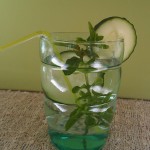
Cucumber spa water with mint is a tasty and refreshing way to infuse your water with minerals and vitamins.
Craving water with a little extra flavor in it? Then you may enjoy making your own spa water occasionally. Depending on the fruits, vegetables, spices, and herbs you add to it, spa water offers a nice range of minerals and vitamins, not to mention great health benefits. It’s a great substitute for soda and juices. Plus, kids really enjoy spa water, too.
One of my favorite spa waters is “Cucumber-Mint Medley,” because cucumber water is full of such health benefits as I describe in “7 Compelling Health Reasons to Drink Cucumber Water.” Another good spa water to try is lemon water, which has many benefits as described in “Zest Up Your Wellness Routine with Lemon Water.” But if you crave something sweeter, give this “Pomergranate-Berry Spa Water” recipe a try. Let me know which one is your favorite!
6. Add a greens blend to your water
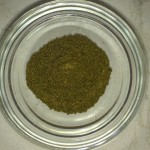
Mixing in an organic greens powder adds minerals, vitamins, and more to your water, so it’s a great energy booster.
Now this solution is only a winner if you don’t mind drinking green water! But I wanted to mention it because it makes a powerful energizing drink that is especially great after working out. And it won’t necessarily taste like algae, because you can get these blends in natural flavors like lemon-lime or berry. I’ve often used the unflavored ones, though, since “natural” doesn’t always mean it’s truly natural.
Available in powder form, many manufacturers offer greens powder blends derived from veggies, herbs, grasses, algae, and grains that are not only full of trace minerals and macro minerals, but other goodies like chlorophyll and vitamins, too. In addition, many blends boast that they provide fiber, prebiotic, probiotic, enzyme, and antioxidants benefits as well. Be sure to read labels carefully to make sure you get what you want as there are many choices.
7. Use a pH-balancing filter for your reverse osmosis system
Does your RO water taste too pure? That’s probably because about 99% of the minerals have been stripped from it. Correct the problem by raising the pH and adding calcium and magnesium back in with a simple filter, which is often called a pH-balancing, calcite, or remineralizing filter. By the way, you may not necessarily have to change your RO system, because it’s an add-on filter. But you will need to change the filter occasionally — perhaps twice yearly — and pay around $30 – $50 each time for a new one.
How much calcium and magnesium does such a filter add back? And what is the final pH? That is dependent on three factors: water temperature, flow rate, and the original pH of the water according to a technical representative at Premier, a manufacturer of Watts Premier RO filtration systems. Unfortunately, the pH and actual amount of minerals cannot be determined without doing a test according to the company. When testing my own system, I found that the filter helped raise the pH, but that the total hardness of the water was quite low at 25 ppm, so it didn’t really seem to add back in a substantial amount of minerals.
Note: If you’re not sure about the pH or hardness (i.e., mineral content) of your water, you can check both using simple test strips. Sometimes you can also get your water tested for free at a pool and spa supply store or a supplier of water filtration systems. By the way, I discovered that calcium is usually easy to test for, but magnesium may require a more complex and expensive test that a lab needs to do.
Copyright © Karen Peltier and Well Gal, 2014 – 2019. All rights reserved.
Photos © Karen Peltier and Well Gal, 2014 – 2019.

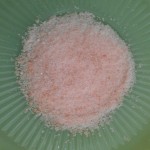
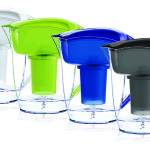
Wow 🙂
This is an incredible collection of ideas!
Waiting for more helpful pieces.
You would amazing to read a similar one here-
bestofcleaner
I suffer from trigeminal neuralgia. I have to be very carefull what I eat and drink. To reminiralise is tricky for me. I have to take minimum metals, also the good ones. So himalaya salt is tricky. It contains metals. Teaspoon per liter? An eighth?
I had blood tests after using RO water for a year. Results shocking. The dead water STEALS all your vitamins and minerals from your small intestines and colon. Osmose. You urinate it all out: Your expensive supplements. My bloodworks looked as if I was undernourished. There was no sign that I use supplements and eat healthy and drink 2 lt of water per day. My bloodcells appeared dehydrated. It affected my immunity as well. Very low T cells. It is very important to reminiralise your RO water ( or distilled water). My bloodtests confirms it.
What are you using now? I am trying to find good water source that I can use.
I would go look at the (RW) reduced water system, I purchased one called Enagic this enables me to drink the best superior water daily.
I too had health issues but found by drinking over 3 litres daily of Ionized reduced water I got to my optimum hydration and I wouldn’t go back to just the filter system I had for 8 years.
I didn’t realize that there were so many ways that you could add healthy minerals into your water. I agree that doing something like making a glass of spa water could be a good way to get more minerals in your water. Perhaps it would be a good idea to look into getting well water pumped into your home. That type of water always seems to have healthy minerals in the water.
Great ways to make water healthier! Though I have been interested in this theme for a long time, I never heard about some of the ways. For instance, I didn’t know you can put sea salt into water as I always thought it is used for baths only. As for alkaline water pitchers, you offer Santevia model and I use it as well. In my opinion, it is the best pitcher on the market.
Thank you so much for writing such a helpful blog for us. As water is an essential element in our life, whose be taken care of without any negligence. MSK (https://www.mitrask.com/) is famous for many another testing laboratory like Mineral testing (Iron ore, ferroalloys testing&analysis, Coal &Coke Testing) Environment Testing, Food testing &analysis.
Hi Karen, Great article. Didn’t know there were ways to make regular drinking water more mineral-rich. Thanks for sharing this informative guide. Really helpful.
Hello Karen,
Thanks for your informative article. I recently came to the conclusion that my kids and I are missing something ***. Lack of appetite and energy – combined with slower growth (my kids are all a bit short for their age). Although their / our diet is sound, we all have the same symptoms. Its led to me consider what the root cause may be. For starters my wife does not have the issues we have. I attribute this to her drinking liters of bottled (glass) sparkling mineral water.
Sparkling water is very acidic, always drink ‘plain’ water. Preferably ionized alkaline water.
How about Epson salts bath to add minerals to your body?(adorned through our largest organ, our skin)
Has anyone checked out waterdynamix.net. the water goes though a RO and other filters then it adds minerals back into the the water by injection so it’s very precise. The best part is you can watch it working…thought I would pass that on if anyone ever wanted to add choice minerals automatically.
great article
but i have 1 question that why we have to add exstra mineral in distilled water which are already containe void of minerals by ro process.
Ro/ soft water significantly increases the risk of heart disease. Minerals are needed to reduce the risk
Great Article
but have 1 Question that why we have to adding mineral in distilled water which are already void of mineral having by ro process
Good article with great remineralizing options. I’d like to know which is best for babies/children in an RO household? I would just be worried about over burdening their kidneys.
Thank you.
Adding Mineral drops? I would have never thought of that. My wife and I are thinking of spending like $3000 for a water filter. I think we need to do some more research. Thanks. Nice read
Hi Karen,
As always an interesting read. I agree with your points as I have personally tried this & I appreciate your efforts that you have selected this topic to write an article.
By the way, It’s always pleasure to read your posts and comment.
~ Donna
Thank you for sharing such a helpful and interesting post. Water is your life source, so to make additions that can improve your health is a great bonus!
Hi Karen Peltier
Nice Info it is very knowledgeable for all we are in water treatment business for the last 7 years i know that what is the value of pure drinking water for humans as well for every one.
Thanks keep it up.
Sujeet Singh
Delhi – INDIA
Hello Karen!
Thanks for sharing such a wonderful information on this much talked about topic. Drinking water void of essential minerals can cause several health hazards. In India, RO water purifier is becoming more and more popular these day, if the TDS level of water is high. I would like to add some insights about the RO water purifiers which you have not discussed here in article. People often ask “Is RO Water Safe to Drink“. RO water is completely safe to drink and now a days most of the water purifier brands uses “TDS Controller” inbuilt with RO purifier, which helps in retaining essential minerals in drinking water. That means you don’t need to add anything from outside to add minerals in RO water. It will automatically be retained in drinking water which is completely healthy and safe.
thanks for sharing this info. if TDS can be controlled in RO water, that’s very good but how about plasticity in RO water. plastic can be mix in RO water like bottled water. thanks.
Hi Pooja,
RO water purifiers uses ABS Food grade Plastic which is completely safe for water storage and consumption. Also, I would like to add that while searching for water purifier you must check the certifications that particular brand has received. This will ensure that the product has gone through testing and its safe to use. I am using KENT RO Water Purifiers as it’s models are certified by various organizations like NSF, WQA, ISO etc. You can also opt for top water purifier brands to be sure of quality. For your reference here is the list of top 3 best RO Water Purifier in India
I would recommend HiFlowAM Water.
Alkaline water is really good. I drink it everyday
“All normal cells have an absolute need for oxygen, but cancer cells can live without oxygen – without a prescription,” says chemist Otto Heinrich Warburg. Exceptional exception “. “Cancer cells are acidic, while healthy cells are alkaline.”
why when i am attempting to remove fluoride would i add droppers of micro nutes which includes FLUORIDE back into my water (crazy unconscious article ) unbelievable
not only that its now widely accepted that fluoride is a neuro toxin which was also used by the nazi during ww2 to dull down locked up prisoners in concentration camps
lets see if easily verified facts easily researched will pass the test of moderation over EGO ,,,i dought it
What are ‘micro nutes’? Where did you get the flouride bit?
This is what is contained in the trace mineral drops: Magnesium, Chloride, Sodium, Potassium, Sulfate, Lithium, Boron.
Exactly. I just use reverse osmosis water and add some magnesium and calcium in each bottle . I have a dose of calcium that I split up into 4 parts and add it to 4 bottles of water and then the same with the magnesium. Just to give it some minerals
According to the World Health Organization, minerals in drinking water are necessary for good health. They also warn against drinking fully demineralized water which is associated with several modern diseases. All of this is backed by research. Read the document “Nutrients in Drinking Water” published by the WHO in 2005. In that document, they explain the benefits of fluoride too. Bottom line, you need it for dental and bone health. Too much is not good either. Like a lot of things, there’s a healthy balance that is necessary and good.
Fluoride is actually minute aluminium particles, a byproduct of toxic waste that was dumped into our drinking water by governments that have very little desire to keep you healthy. Actually research what fluoride is before you believe and spread information about its “health” benefits which are inherently wrong.
Actually, fluoride is a naturally-occurring mineral. The discovery of it’s benefits to teeth was because some communities had less dental problems than others. When they finally got around to testing the water supplies of these areas, they found a direct correlation between communities with natural fluoride in their water, and better overall dental health. Perhaps you should take your own advice, and do some real research before you spread misinformation.
You’re parroting the same propaganda pushed by those who push fluoride on us. Flouride is natural but that’s NOT what’s being added to our water. Over 91% of US water is treated with hydroflourosilicic acid and sodium silicoflouride – now read this to understand where the “logic” for this originated:
http://fluoridealert.org/articles/aluminum-industry/
Furthermore, something added topically to teeth to allegedly improve dental health should NOT need to be swallowed, like tap water. Flouride chemicals have been proven through numerous studies to have adverse affects on brain function, including lowered IQ. Maybe that’s why only 5% of the global population drinks fluoridated water (and over 50% live in the U.S.).
Check out this site and the current lawsuit against the EPA:
http://fluoridealert.org/content/bulletin_12-22-17/
Scroll down to see the timeline and arguments made from both sides. Luckily the move to dismiss was DENIED just last week and the case will move forward!!
there is a massive difference between the required nutrient, calcium flouride, and what is put into drinking water which is sodium flourosilic acid which is a waste product from industrial agriculture
These are great tips! Spa water is so refreshing, I like how the flavor options are endless.
Hi! Thanks for all your great suggestions. I’m in a rural area, and our well water is full of all sorts of nasty stuff, so we’ve got a whole bank devices for water-filtering, ph-balancing, softening, bacteria-destoying, you name it in our basement. I’ve been using Omniblue Ocean Minerals to re-mineralize my water for six months now. I love how it makes the water feel and taste, and I like the fact that it comes from the ocean, in the natural proportions of minerals and trace elements that are in sea water. You may want to add this to your list of products to check out.
Hi. We buy RO water from a water machine at the store and I want to remineralize the whole five gallon bottle before I stick it on the dispenser. Would any of these be an option to do that? I worry the salt would settle at the bottom of the dispenser and wouldn’t be even throughout all of it.
I 2 want to add to my 5 gallon RO water, what did you find out?
These are a whole new way to be healthy. Thank you Karen for sharing this wonderful post. I love it so much. I’ve learned a lot.
great!
Why is the colourless water considered to be good or pure over coloured water?
You could of course not distill the water in the first place 😉 But I assume there may be a good reason to do so – contamination with heavy metals / arsenic / other nasties? I would actually not worry too much about adding things back in; if you look at some of the bottled waters on the market, they are almost as devoid of trace elements as distilled water.
well what is worse than lack of minerals you can bet by eating meat and veggies. Or drinking deadly floride, choloraphyll.?
Awesome share!!
Water prompts expanded vitality levels. The most widely recognized reason for daytime weakness is really mellow lack of hydration. Water normally saturates skin and guarantees appropriate cell arrangement underneath layers of skin to give it a sound, gleaming appearance.
My roommate hates the taste of tap water and has installed a filter on the sink. I had no idea that you could get an alkaline pitcher to put minerals back into the water. I’ll have to see about getting one of these so that my water can taste good again.
Karen- I am replacing my existing RO system. Worked OK, but the filter costs are prohibitive (nearly $200 for the membrane). Anyway, I am considering one that adds minerals and does something about the alkalinity of the water.
My question is about the minerals and alkalinity business. How do I know what is added back into the water is balanced correctly — what if it add too much?
Is there any way to control this. Would drops in the water be better?
Hi Ron,
Million dollar questions! I do know you can simply test the pH of your water with pH strips to determine the alkalinity. Or, as I mentioned in the article, go to a pool supply store.
With regard to what minerals are getting added back in, I suggest asking the tech at the RO company what their product actually does. If you’re using a pitcher, directly asking the company if they got stats on what their filter does is also helpful. In the past, when I approached some companies at a Natural Products Show and asked them these questions, I found some were definitely more informative than others. I realized the best companies to go with are the ones that have data on what their product filters out and also what it may put back in.
With regard to drops, you can tell exactly what you’re putting in your water if you buy from a company that publishes such info. For example, Trace Minerals Research has a Certificate of Analysis sheet on their website that shows the exact quantities of minerals that are getting put back in your water when you use their product. So, in that way, there’s no guessing.
So, maybe a good solution is a combo? For example, first use a pitcher or a RO filter that puts calcium (and if one exists, also magnesium) back into the water. Then add in trace mineral drops or a pinch of Himalayan sea salt to the water. That way you at least have something much better than you started with.
What do you think? Let me know what you end up settling on that works for you.
Karen
Great share,,,
Water leads to increased energy levels. The most common cause of daytime fatigue is actually mild dehydration. Water naturally moisturizes skin and ensures proper cellular formation underneath layers of skin to give it a healthy, glowing appearance.
Hi Ryan,
I couldn’t agree more. Using properly remineralized water is so vital for our health and energy levels. And you’re right about our skin. If that’s dehydrated, just imagine what shape the rest of the cells in our body must be in!
Karen
Hello Karen,
Thanks for your informative article. I recently came to the conclusion that my kids and I are missing something ***. Lack of appetite and energy – combined with slower growth (my kids are all a bit short for their age). Although their / our diet is sound, we all have the same symptoms. Its led to me consider what the root cause may be. For starters my wife does not have the issues we have. I attribute this to her drinking liters of bottled (glass) sparkling mineral water. The rest of us only drink bottled water. I never studied the labels because the print is in Greek (Cyprus). This weekend one of my Greek friends pointed out that the bottled water in question contained a lot of chlorine. He went on translating further … Voila. I think our drinking water is void of any good minerals. And, whenever we drink any, we get a strange “”turning”” feeling in our stomachs. So, I recon its time to start distilling the local toxic tap water and adding minerals to it after. The big question to you is… which of the seven solutions you’ve mentioned, would you recommend? Have you numbered them in that way? Finally, what about calcium?
Btw, I checked the bottled water label, it seems to contain several minerals and origin is “Spring”. Still, I don’t trust it. Or should I?
Hi Rob,
When in doubt, I’ve found one of the best ways is to contact the company directly and inquire about the source. If that can’t tell you then “spring” water may be a fallacy!
Karen
Hi Rob,
Thanks for sharing your experience with us and glad you found the culprit! Chlorine in bottled water doesn’t sound desirable — or healthy.
The solutions I listed aren’t necessarily in any recommended order, but if you are after getting calcium in your water an alkaline water pitcher like the one mentioned in #7 may be helpful and easy for the family to use. I also recently discovered another water pitcher that adds both calcium and magnesium back into the water. It’s called Laica and you can find it on Amazon. It’s an European brand so perhaps you can find it in stores in Greece, also.
Another option is to install a reverse osmosis (RO) filter system and add on a pH-balancing, calcite, or remineralizing filter. That way you’ll get calcium back in the water; however, to add more minerals back in I’d then add that RO water to a pitcher and add in a pinch of Himalayan salt or trace mineral drops.
Karen
It’s cool that there’s water bottles on the market that can ionize and filter the water by themselves. I’ve sometimes encountered awful tasting tap water, so being able to ionize it and carry it around with me sounds pretty great. I may have to look into a water bottle like that, or just get an ionized water system for my fridge or sink. Thanks for the tips.
So, I noticed that when you mentioned that one of the systems replaced vital minerals and you listed a few like chromium, copper and FLORIDE! ?!?
Isn’t the FLORIDE that is added by councils, the main reason people want to use reverse osmosis in the first place? Can you please explain your views on fluoride and also why you think we would want it added back in? Not a tracking you, though my bluntness may make it seem that way.. But I’m actually genuinely interested.. Is it because there may be a difference between naturally occurring fluoride and the industrial waste product that is added to town water supplies?
Cheers
I AGREE and why isn’t this question answered or the issue addressed/answered? Can you please respond?
I’ve thought about using remineralization drops but don’t understand why on earth THEY CONTAIN FLUORIDE?!
Hi April,
Great questions! I’m not in favor of water treatment plants adding fluoride to water, which really deserves a whole blog post dedicated to that. One reason has to do with the health effects of adding too much and the other has to do with the type of fluoride added. According to the Center for Disease Control (CDC), here is where the fluoride comes from:
“Most fluoride additives used in the United States are produced from phosphorite rock. Phosphorite is mainly used for manufacturing phosphate fertilizer. Phosphorite contains calcium phosphate mixed with limestone (calcium carbonates) minerals and apatite—a mineral with high phosphate and fluoride content. It is refluxed (heated) with sulfuric acid to produce a phosphoric acid-gypsum (calcium sulfate-CaSO4) slurry.
The heating process releases hydrogen fluoride (HF) and silicon tetrafluoride (SiF4) gases, which are captured by vacuum evaporators. These gases are then condensed to a water-based solution of approximately 23% FSA.
Approximately 95% of FSA used for water fluoridation comes from this process. The remaining 5% of FSA is produced in manufacturing hydrogen fluoride or from the use of hydrogen fluoride to etch silicates and glasses when manufacturing solar panels and electronics.”
So, when water treatment plants add flouride, it definitely appears to NOT be so natural. Whereas, the flouride in ConcenTrace mineral drops is naturally present. Trace Mineral drops are from a natural source — and you can control how much you add according to your own needs. So, I like the idea of control. To see exactly how much flouride they contain, I checked out their Certificate of Analysis sheet. It said they contain 4 mcg/ml of flouride.
Is this amount OK? According to the National Cancer Institute in this article, “Water fluoridation is the process of adding fluoride to the water supply so the level reaches approximately 0.7 ppm, or 0.7 milligrams of fluoride per liter of water; this is the optimal level for preventing tooth decay (1).” If my math is correct, that converted to gallons is just under 3 mg per gallon.
The Trace Minerals Research website suggests you add 20-40 drops of ConcenTrace per gallon of reverse osmosis or distilled water to re-mineralize it. [So, let’s say 1 ml. = 20 drops (according to a Google search)]. That means you’re getting about 4-8 mcg (or .004-.008 mg) of fluoride in a gallon of water when you use ConcenTrace liquid mineral drops (based on their analysis sheet). In other words, it’s hundreds of times less than the government recommends. So, it appears you’re probably in the safe zone when it comes to using these drops with regard to fluoride. You are indeed getting trace amounts of it versus mega amounts!
Is fluoride necessary for good health? According to this Medline Plus article by the U.S. National Library of Medicine, fluoride is considered a trace mineral that your body needs in small amounts. It states: “Your body needs just small amounts of trace minerals. These include iron, manganese, copper, iodine, zinc, cobalt, fluoride and selenium.” And in this article, it actually goes into depth about just how much fluoride you need. For example, for males over 18 the recommendation is 4 mg/day; whereas for females over 14 it’s 3 mg/day.
By the way, you can get fluoride from other sources than water (e.g., seafood and tea).
Once again, great questions! I hope I answered them accordingly. So much more could be said about the fluoridation of water and health effects, though. So, I do understand your concerns. Perhaps I’ll get a chance to write about the subject in depth sometime.
Karen
Couldn’t agree more!!!! Fluoride is a potent neurotoxin, whatever the source.
Endocrine disruptors seem to be the newest and perhaps the most dangerous of all chemical by-product threats to humanity. I have been looking for a filtering process to eliminate them from water , yet , have found none. Any information would be helpful to me. Thanks
Hello Karen! I was just curious, and maybe you can help me with the answer, how come when i put the ConcenTrace Minerals in my water it still reads that it is acidic on my ph strips?? I usually just drink Evian water but thought I would try filtering my tap water and just adding minerals instead. Aren’t mineral drops suppose to make your water more alkaline or am i just not understanding in full how minerals work in water? please help!! Thank you very much!
Emily
I do the same with my family and myself. Keep drinking Evian water, though is expensive but worth it. Almost all distilled water comes from water treatment plants. According to EPA hundreds of toxic chemicals are in distilled tap water and are not regulated yet by FDA. Evian water is a natural spring unfiltered source, therefore several beneficial minerals are present, filtered by virgin soil. In defect of this i would use Sea salt from the Mediterranean, has around 10 minerals more than Himalayan salt. Sad that you will generate lots of trash but if you have a recycling program will help. You have to see for the health of your beloved ones first.
Had no idea reverse osmosis water I’m filling my 3 gallon bottle with was so depleted until a friend mentioned. He told me about the himalayan sea salt but now how much. Presto, there you are with lots of answers, and I appreciate you so much. Sounds like the easiest solution for me. Thanks……..
Hi Sandra. I’m glad I could be of help and that you found an easy solution that works for you! Himalayan sea salt is a pinch to use!
I noticed you don’t list charging your water with a water charger or by leaving it in sunlight, is this because you don’t recommend this approach? Thanks for the post!
Hi Peter,
I’m simply not familiar with those methods for putting minerals back into drinking water. If you have any info, please feel free to share!
Karen
Hi
Thanks for a great and helpful post.
I have been thinking of recently getting a water distiller but after reading the pros and cons about it it’s made me a little worried whether it is a good idea
Any tips would be helpful… would it be ok to to get distilled water then add minerals such as calcium and magnesium to it to receive the benefits for our bodies?
I have a family and drinking pure clean water is very important to us as we rely heavily on bottled water but is turning out to be alot more expensive..
Any tips on using a water distiller and addING minerals to that?
Many thanks
Thanks for your question. Distilled water is completely void of minerals, so looking for a way to get the beneficial minerals back into your water is a good idea. Unfortunately, aside from the methods listed in my post, I’m not familiar with a specific method for distillers. I’ve personally never used one. If you discover something, please do share it with me!
Karen
If you add minerals in the water will your body receive them? Or will the distilled water absorb them, and more of your body’s nutrients?
Thank you for these tips. My husband and I will be discussing what will be the best for our family. We exclusively drink our water from a reverse osmosis tap and had no idea until yesterday that it was stripped of all it’s beneficial components. I worry about how this affects us and my two children.
Hello Danielle.
Thanks for stopping by and leaving a comment. I too worried about how having clean, but basically mineral-void water impacted my health and that of my family, which is why I researched options for adding minerals back in to reverse osmosis water.
I hope some of the solutions I offered are a good fit for your family.
Karen
Good, I am Rajesh Purohit, have developed “Jalsujal-106” Mineral Salts Composition powder to add to any demineralised water to be used to drinking & cooking water. It will give pleasant test to water, make enough alkaline, improve many health problems and give many more benefits for easy living.
I am basically R&D scientist and worked about 35 years as Chief Scientific Officer at Govt. of Gujarat (State of India) with water department only. Yet some R& works are going on by me too. I am running age of 68 years only.
Hello Rajesh.
Thanks for writing in and mentioning your mineral salts powder product that remineralizes the water. Sounds interesting! I’ll check it out.
Karen
Hello, I searched your product online and was able to find the website. However there was no nutritional breakdown given of the product. I’d like to know how your product compares to the ones I can buy here.
I have looked at your site. Tried to purchase the product online but it does not seem to be available. Please let me know how I may purchase a pack.
Thank you so much for this post! I am a long-time drinker of bottled water but was getting a little frustrated with higher prices (I exercise a lot, so I need lots of water on the go). I was also dismayed by how many “different” kinds of water are now offered (e.g. purified, spring, artesian, etc.) I was considering buying artesian water in bulk until I discovered you have to buy at least 4 cases at once! In frustration, I did a google search for “adding minerals to water” and found the Well Gal blog. I will be buying the Himalaya salt and adding it to my boiled water from now on. My process is to boil the water, let it cool and then pour it into bottles. Thanks again for a practical, healthy, and affordable way to avoid buying non-nutritional water and saving a buck!
Hi Colette.
Glad I could be of help!
Karen
Boiling water does not remove minerals. It will kill bacteria, and chlorine will gas out. But most dissolved solids will remain. No need to replace.
what about just leaving your water in the sun for 15-20 minutes to remineralise it?
Hi Dave.
Thanks for the question. I haven’t heard about leaving water in the sun to remineralize it, though it seems like it could enliven it somehow. Have you heard of this technique somewhere? If so, please share what you know. Sounds like an interesting concept indeed.
Karen
LOL.
Thanks Karen!
Now i know ‘why” drinking my tap water does very little for me!
Other than probably slowly contribute to my not being as nearly healthy as I could and should be!
You really provided a ton of extremely practical value! And I just may have to give those
droplets a try!
It’s simple and very affordable! Thanks!
Great post. There are times when I drink water and feels dull and tasteless . I like what you have given us it makes the water tasty as well as give us essential minerals for our health. I will certainly try these tips.
Hello Siphosith.
Thanks. There’s nothing worse than drinking “dull” and “tasteless” water. And when we do so, I think our body knows it needs more. So, I’m glad you found these tips for how to bring some life back into your water useful. 🙂
Karen